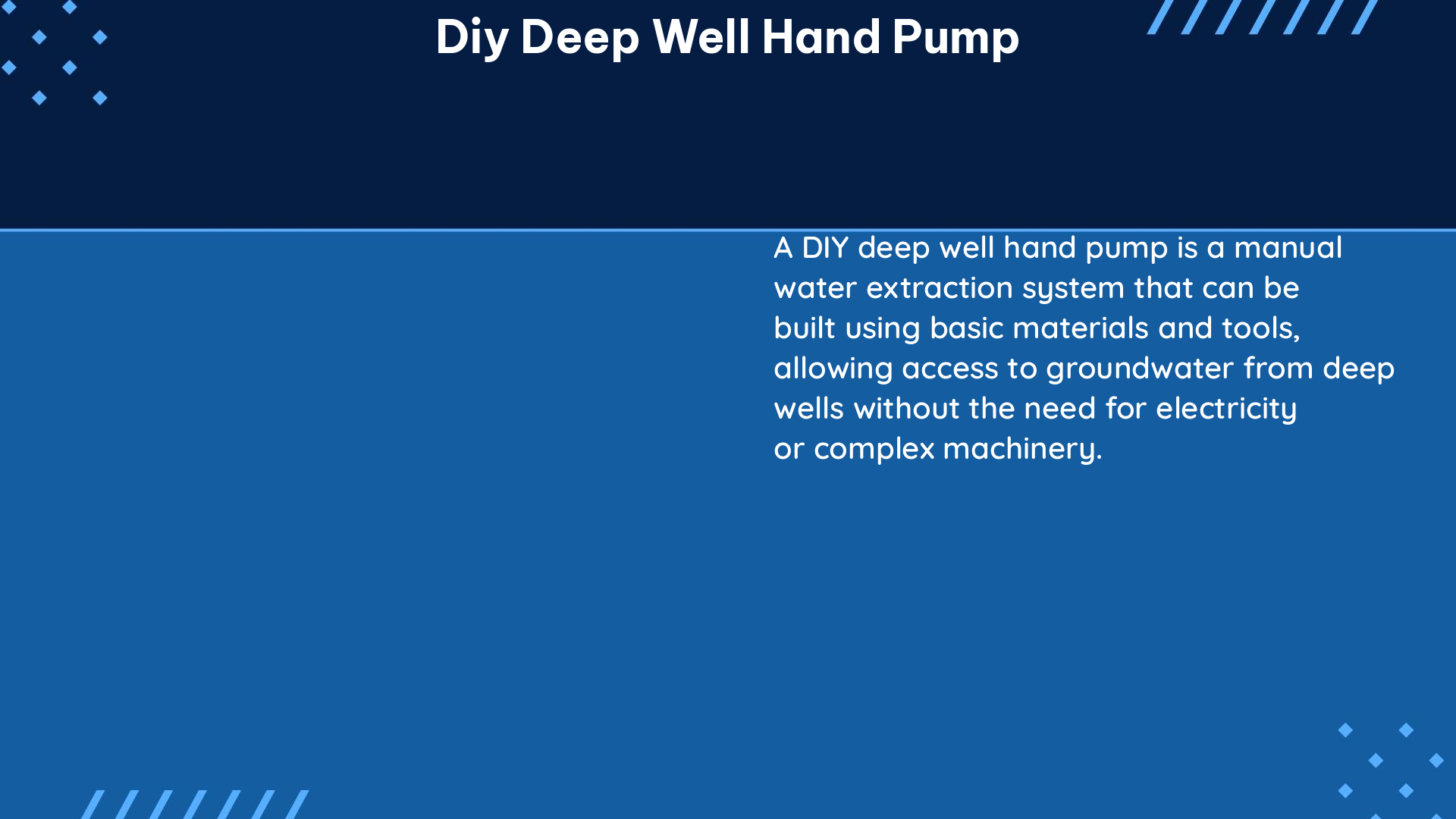A DIY deep well hand pump is a reliable and cost-effective solution for accessing water from deep underground sources, making it an excellent choice for off-grid living or areas with limited access to electricity. This comprehensive guide will delve into the technical specifications, materials, and step-by-step installation process to help you create your own deep well hand pump.
Technical Specifications for DIY Deep Well Hand Pumps
Well Depth
The average water table depth can range from 50 to 200 feet, but with a deep well hand pump, you can access water from much greater depths. The Simple Pump, for instance, has the capacity to pump water from as deep as 325 feet, making it a suitable option for even the deepest wells.
Pipe Length
For a deep well, you may require pipe lengths up to 135 feet, as demonstrated in various installation videos and tutorials. The exact pipe length will depend on the depth of your well and the specific requirements of your DIY deep well hand pump system.
Materials
When constructing a DIY deep well hand pump, common materials include:
- PVC pipes: These are easily sourced, affordable, and durable, making them a popular choice for the main pump body and piping.
- Check valves or foot valves: These are essential components for maintaining the pump’s prime and ensuring initial priming.
- Stainless steel or brass hardware: These corrosion-resistant materials are preferred for the pump’s moving parts, such as the handle and connecting rods.
- Rubber seals and gaskets: These help create a tight seal and prevent water leaks.
Step-by-Step DIY Deep Well Hand Pump Installation

Assessing Well Conditions
Before installing a deep well hand pump, it’s crucial to understand your well’s static water level. This can be determined by consulting a well log or by testing the water level during the installation process. Knowing the static water level will help you select the appropriate pump and ensure it can effectively draw water from the desired depth.
Removing the Old Well Cap
If you’re replacing an existing well setup, the first step is to remove the old well cap. This typically involves disconnecting any electrical wiring or power sources connected to the well.
Installing the New Well Cap
The new well cap should be machined to accommodate the deep well hand pump. This may require drilling holes or modifying the cap to fit the pump’s components, such as the pump handle and connecting rods.
Leveling the Pump
Ensuring the deep well hand pump is level is essential for optimal performance. Use a level to adjust the pump’s position and secure it in place, ensuring it operates smoothly and efficiently.
Priming the Pump
Priming the pump is a crucial step to establish the initial suction and water flow. This may involve filling the pump body with water or using a check valve or foot valve to maintain the prime.
Connecting the Piping
Carefully connect the PVC pipes to the pump’s inlet and outlet, ensuring a secure and leak-free connection. The pipe length should be appropriate for the depth of your well, as mentioned earlier.
Testing and Adjusting
Once the installation is complete, test the pump’s operation by manually operating the handle. Observe the water flow and make any necessary adjustments to the pump’s positioning or connections to ensure smooth and efficient operation.
Unique Perspectives on DIY Deep Well Hand Pumps
Off-Grid Solutions
Deep well hand pumps are an excellent solution for off-grid living, providing a reliable water source without the need for electricity. This makes them particularly useful for remote cabins, homesteads, or disaster preparedness scenarios where access to grid-powered water systems may be limited.
Ingenuity and Cost-Saving
DIY deep well hand pumps allow for creative problem-solving and cost savings. Inventors like Darren Holliday have demonstrated their ingenuity by developing innovative solutions, such as a rock extractor and hand pump machine, to overcome challenges and reduce the overall cost of deep well hand pump installation.
By understanding the technical specifications, materials, and step-by-step installation process, you can create a reliable and cost-effective deep well hand pump for your home or off-grid property. This guide provides a comprehensive overview to help you navigate the DIY journey and enjoy the benefits of a self-sufficient water source.
References:
- Permies.com – Deep Well Hand Pump Installation
- YouTube – Deep Well Hand Pump Installation
- GrayWolfSurvival.com – Make a Hand Pump Work
- MotherEarthNews.com – Living Off-Grid with a Homemade Deep Well Pump
- HarrowsmithMag.com – Deep Well Hand Pump: Pump It Up

The lambdageeks.com Core SME Team is a group of experienced subject matter experts from diverse scientific and technical fields including Physics, Chemistry, Technology,Electronics & Electrical Engineering, Automotive, Mechanical Engineering. Our team collaborates to create high-quality, well-researched articles on a wide range of science and technology topics for the lambdageeks.com website.
All Our Senior SME are having more than 7 Years of experience in the respective fields . They are either Working Industry Professionals or assocaited With different Universities. Refer Our Authors Page to get to know About our Core SMEs.